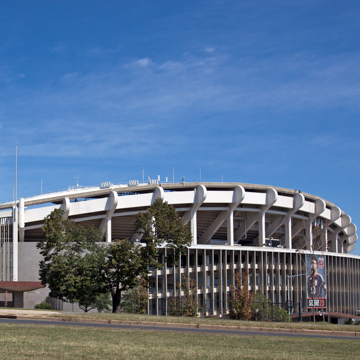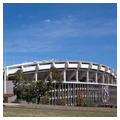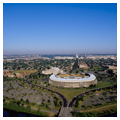The Robert F. Kennedy (RFK) Stadium is located at the easternmost terminus of East Capitol Street, near the banks of the Anacostia River. Allied Architects of Washington, D.C., a confederation of prominent local architects, proposed construction of a national stadium on the site as early as the 1930s. The RFK Stadium forms a commanding focal point for this vista, although from the residential areas, it is somewhat obscured by the heavy tree lines of East Capitol Street. Its large size makes it visible from many parts of the northeast and southeast sections of the city. Constructed in the early 1960s, it was named in honor of Kennedy after his assassination in 1968. The RFK Stadium was one of the first major stadiums designed to host both baseball and football games.
Dallas architect George L. Dahl designed the stadium in a nearly perfectly circular plan. The stadium slopes toward the playing field, much of it protected with a cantilevered roof over the upper deck. The roof also serves as support for the lights—light towers were forbidden since the stadium is on a direct sightline with the Washington Monument and the U.S. Capitol. From the exterior, the waving lines of the stadium walls and the slope of the stadium seats give the impression of an elliptical structure in motion—a roller coaster-like form of reinforced concrete bents and steel supports. On the interior, the building presented unfamiliar levels of comfort in the shape of larger seats, brighter lights, air-conditioned locker rooms, and a special lounge for players’ wives.
In 2019, Events DC announced plans to demolish the stadium by 2021, citing maintenance costs as the principal issue. The use of multipurpose stadiums also declined in part thanks to the changes in turf installation, which now must be permanent and adjusted for particular sports.
References
Peatross, C. Ford, ed. Capital Drawings: Architectural Designs for Washington, D.C. from the Library of Congress. Baltimore: Johns Hopkins University Press, 2005.

















